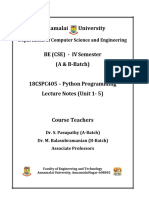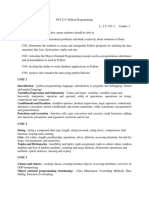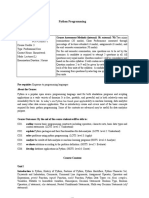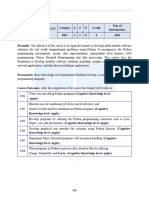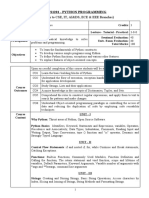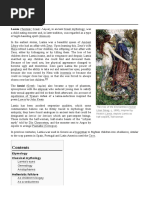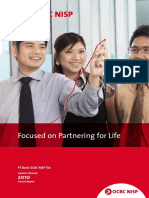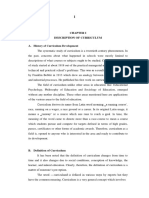0 ratings0% found this document useful (0 votes)
188 viewsPython Syllabus
This document provides information about the 4706- PYTHON PROGRAMMING course. The course is a 2-credit core programme course taught over 0 lecture hours, 0 tutorial hours, and 0 practice hours. It is evaluated through continuous assessments worth 30% and an end semester exam worth 70%. Upon completing the course, students will be able to understand Python fundamentals, construct common programming idioms, analyze string functions and files, and understand regular expressions. The course content covers variables, conditionals, functions, iterations, strings, files, and regular expressions. Reference materials include textbooks and online resources.
Uploaded by
ganeshCopyright
© © All Rights Reserved
We take content rights seriously. If you suspect this is your content, claim it here.
Available Formats
Download as DOCX, PDF, TXT or read online on Scribd
0 ratings0% found this document useful (0 votes)
188 viewsPython Syllabus
This document provides information about the 4706- PYTHON PROGRAMMING course. The course is a 2-credit core programme course taught over 0 lecture hours, 0 tutorial hours, and 0 practice hours. It is evaluated through continuous assessments worth 30% and an end semester exam worth 70%. Upon completing the course, students will be able to understand Python fundamentals, construct common programming idioms, analyze string functions and files, and understand regular expressions. The course content covers variables, conditionals, functions, iterations, strings, files, and regular expressions. Reference materials include textbooks and online resources.
Uploaded by
ganeshCopyright
© © All Rights Reserved
We take content rights seriously. If you suspect this is your content, claim it here.
Available Formats
Download as DOCX, PDF, TXT or read online on Scribd
You are on page 1/ 3
4706- PYTHON PROGRAMMING
Course Programme Core Credits: 2
Category:
Course Theory Lecture-Tutorial- 0-0-
Type: Practice: 0
Prerequisi Object Oriented Programming Continuous 30
tes: Using Java Evaluation:
Semester end 70
Evaluation:
Total Marks: 100
Course Upon successful completion of the course, the student will
Outcomes be able to:
CO Understand the fundamentals of Python Programming
1 Language.
CO Recognize and construct common programming
2 idioms: variables, loop, branch statements, functions
and develop Python programs for a given application.
CO Analyze string functions and concept of files in python
3 programming.
CO Understand the concepts of searching and extracting
4 data using regular expressions.
Contributi P P P P P P P P P PO PO PO
on of O O O O O O O O O 10 11 12
Course 1 2 3 4 5 6 7 8 9
Outcomes CO H M M
towards 1
achieveme CO H M M L L M
nt of 2
Program CO M M M M L M L
Outcomes 3
(L-Low, CO M M M H L M L
Medium- 4
M, H-
High)
Course UNIT I
Content Introduction- Why we program, creativity and motivation,
computer hardware architecture, Understanding
programming, Words and sentences, conversing with
Python, terminology: interpreter and compiler, writing a
program, what is a program, the building blocks of
programs, what could possibly go wrong, the learning
journey.
Variables, expressions and statements-Values and types,
variables, variable names and keywords, statements,
operators and operands, expressions, order of operations,
modulus operator, string operations, asking the user for
input, comments, choosing mnemonic variable names,
debugging.
UNIT II
Conditional execution- Boolean expressions, logical
operators, conditional execution, alternative execution,
chained conditionals, nested conditionals, catching
exceptions using try and except, short circuit evaluation of
logical expressions, debugging.
Functions- Function calls, built-in functions, type
conversion functions, random numbers, math functions,
adding new functions, definitions and uses, flow of
execution, parameters and arguments, fruitful functions and
void functions, why functions, debugging.
UNIT III:
Iteration- Updating variables, the while statement, infinite
loops, infinite loops and break, finishing iterations with
continue, definite loops using for, loop patterns, debugging.
Strings- A string is a sequence, getting the length of a
string using len, traversal through a string with a loop,
string slices, strings are immutable, looping and counting,
the in operator, string comparison, string methods, parsing
strings, format operator, debugging.
UNIT IV:
Files- Persistence, Opening Files, Text Files and Lines,
Reading Files, Searching through a File, Letting the user
choose the Filename, Using try, except and open, Writing
Files
Regular Expressions: Character matching in regular
expressions, Extracting data using regular expressions,
Combining searching and extracting, Escape character.
Text books Text Book(s):
and [1]. Charles Severance, Python for Informatics-
Reference Exploring Information.
books Reference Books:
[1]. David M. Beazley. Python Essential Reference.
3rd Ed. Sams, Indianapolis. 2006. ISBN: 067232862
3.H.
[2]. Wesley J. Chun. Core Python Programming.2nd
Ed. Prentice Hall, Upper Saddle River, NJ. 2007. ISBN:
0132269937.
[3].Allen B. Downey, Think Python - An Introduction to
Software Design, Green Tea Press Needham,
Massachusetts, Version 2.0.17, 2012
E- [1].https://www.coursera.org/course/pythonlearn
resources
and other [2].https://www.edx.org/course/introduction-computer-
digital science-mitx-6-00-1x-0
material [3].https://www.thenewboston.com/videos.php?cat=36
[4].http://diveintopython.org/
You might also like
- Introduction To Python Programing: Unit-1No ratings yetIntroduction To Python Programing: Unit-11 page
- Introduction To Python Programming - Theory100% (1)Introduction To Python Programming - Theory3 pages
- Mca2022 - Advanced Python-Programming - (Elective)No ratings yetMca2022 - Advanced Python-Programming - (Elective)2 pages
- Python Programming - Theory - 1010206302No ratings yetPython Programming - Theory - 10102063023 pages
- Course Code CSE3011 Python Programming Course Type LP Credits 3No ratings yetCourse Code CSE3011 Python Programming Course Type LP Credits 33 pages
- Int213:Python Programming: Through This Course Students Should Be Able ToNo ratings yetInt213:Python Programming: Through This Course Students Should Be Able To1 page
- Course Overview:: Course Name: Programming Essential in Python Instructor Name: Shaheryar NajamNo ratings yetCourse Overview:: Course Name: Programming Essential in Python Instructor Name: Shaheryar Najam3 pages
- Ansh Bhawnani: Python Beginner's Course Bitten Tech100% (1)Ansh Bhawnani: Python Beginner's Course Bitten Tech26 pages
- 3-Year Under Graduate Programme in Mathematics Revamped Curriculum Design and Model SyllabusNo ratings yet3-Year Under Graduate Programme in Mathematics Revamped Curriculum Design and Model Syllabus2 pages
- Curriculum and Material Design Developme PDFNo ratings yetCurriculum and Material Design Developme PDF64 pages
- Cincin Separuh Hati Netty Virgiantini 2024 scribd download100% (6)Cincin Separuh Hati Netty Virgiantini 2024 scribd download49 pages
- Cost Structure of Jindal Worldwide LTD: Report: ExhibitsNo ratings yetCost Structure of Jindal Worldwide LTD: Report: Exhibits2 pages
- Life Skills in Classical Tamil Literature, Thirukural: August 2015No ratings yetLife Skills in Classical Tamil Literature, Thirukural: August 20157 pages
- Regulatory Framework and Legal Issues in Business: Law On Credit TransactionsNo ratings yetRegulatory Framework and Legal Issues in Business: Law On Credit Transactions18 pages
- The Evolving Brand Logic A Service-Dominant LogicNo ratings yetThe Evolving Brand Logic A Service-Dominant Logic18 pages
- Reflections on Eight General Conference Sessions (Colin D. Standish Russell R. Standish) (Z-Library)No ratings yetReflections on Eight General Conference Sessions (Colin D. Standish Russell R. Standish) (Z-Library)115 pages
- The Seven Most Important Skills of An Effective Foreman (Part II)No ratings yetThe Seven Most Important Skills of An Effective Foreman (Part II)1 page
- DARK SUN For Basic Roleplaying House Rules (Sept. 10, 2011)No ratings yetDARK SUN For Basic Roleplaying House Rules (Sept. 10, 2011)19 pages
- 1637210840-Time Table - Qualifying January 2022No ratings yet1637210840-Time Table - Qualifying January 20228 pages






